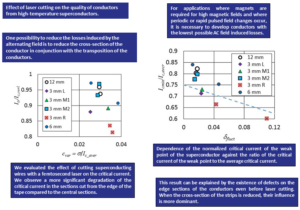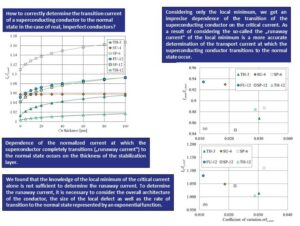Superconductors are materials capable of carrying electric current without resistance and therefore without energy loss. This is true as long as its magnitude does not exceed the value of the so-called critical current.
Composite conductors based on high-temperature superconductors (HTS), cuprate REBa2Cu3O7-δ, reach high transport current densities (1010 [A/m2]) at relatively achievable temperatures of liquid itrogen (‑293 ˚C) at atmospheric pressure. Moreover, a high critical magnetic field makes them good candidates for high-field magnets (tens of Tesla [T]). That makes them an interesting option for high-power cables, magnetic resonance, nuclear magnetic resonance, etc. In contrast to standard copper wires, which have circular cross-sections, and are easy to shape and bend, REBa2Cu3O7‑δ coated conductors are fabricated in the form of thin (1-3 µm), wide (3-12 mm) layers. For effective power transmission and to achieve high magnetic fields, it is necessary to form them into effective cables. A circular cross-section is one of the possible arrangements.
However, the thin layer structure of REBa2Cu3O7-δ coated conductors has mechanical properties comparable to ceramic materials, which limits the bending of the conductor. At certain limits, the degradation of the superconducting layer occurs and can no longer transport current. Our work examines the bending of coated conductor prepared with ISD (Inclined Substrate Deposition) technique dependent on conductor orientation, lay angle, and core diameter. We determine the critical current degradation dependent on these parameters. In conductor orientation with expansive orientation, we have observed degradation of critical current already at 10 mm diameter. However, in case of compressive orientation of coated conductor, it was found that the lowest diameter for conductor bending is 3 mm at 30 deg. At higher diameters (4 mm, 5 mm) we observed mild critical current change up to 60 deg.

 Text: F. Gömöry, M. Mošať
More info:
[1] F. Gömöry, J. Šouc, M. Godár, C. Hintze and V. Grosse, DOI: 10.1088/1361-6668/acb73f
[2] F. Gömöry, J. Šouc, M. Godár. DOI: 10.1109/TASC.2022.3233805
Picture: High Temperature Superconducting (HTS) Rare-Earth Barium Copper Oxide (also referred to as REBCO) power transmission cable used at CERN (Image: CERN)
Source of picture: https://hilumilhc.web.cern.ch/article/completion-hts-rebco-cables
Text: F. Gömöry, M. Mošať
More info:
[1] F. Gömöry, J. Šouc, M. Godár, C. Hintze and V. Grosse, DOI: 10.1088/1361-6668/acb73f
[2] F. Gömöry, J. Šouc, M. Godár. DOI: 10.1109/TASC.2022.3233805
Picture: High Temperature Superconducting (HTS) Rare-Earth Barium Copper Oxide (also referred to as REBCO) power transmission cable used at CERN (Image: CERN)
Source of picture: https://hilumilhc.web.cern.ch/article/completion-hts-rebco-cables

 Text: F. Gömöry, M. Mošať
More info:
[1] F. Gömöry, J. Šouc, M. Godár, C. Hintze and V. Grosse, DOI: 10.1088/1361-6668/acb73f
[2] F. Gömöry, J. Šouc, M. Godár. DOI: 10.1109/TASC.2022.3233805
Picture: High Temperature Superconducting (HTS) Rare-Earth Barium Copper Oxide (also referred to as REBCO) power transmission cable used at CERN (Image: CERN)
Source of picture: https://hilumilhc.web.cern.ch/article/completion-hts-rebco-cables
Text: F. Gömöry, M. Mošať
More info:
[1] F. Gömöry, J. Šouc, M. Godár, C. Hintze and V. Grosse, DOI: 10.1088/1361-6668/acb73f
[2] F. Gömöry, J. Šouc, M. Godár. DOI: 10.1109/TASC.2022.3233805
Picture: High Temperature Superconducting (HTS) Rare-Earth Barium Copper Oxide (also referred to as REBCO) power transmission cable used at CERN (Image: CERN)
Source of picture: https://hilumilhc.web.cern.ch/article/completion-hts-rebco-cables 




